Cavalry - an overview
Over the centuries of its existence, the Roman army used a variety of cavalry support units. The early legions were supported by 300 equites formed into a unit. In the latter years of the Republic Caesar, for example, employed thousands of allied cavalry. At times, during the empire, the role of the cavalry amounted to a few hundred support units. This page is not an attempt to describe these cavalry units in detail but is only intended to give a general view of the cavalry units and their sizes relative to the army as a whole. 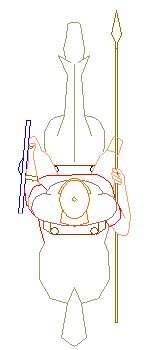 The basic cavalry soldier was almost always armed with a shield and stabbing/throwing spear, supplemented by a sword. The Romans were never noted for using mounted archers, for example. The appearance of the cavalry soldier would surely have changed over time but the figure would be a good generalization of the soldier at almost any time in Rome's history.
The basic cavalry soldier was almost always armed with a shield and stabbing/throwing spear, supplemented by a sword. The Romans were never noted for using mounted archers, for example. The appearance of the cavalry soldier would surely have changed over time but the figure would be a good generalization of the soldier at almost any time in Rome's history.
 Each Ala had an aeneator, shown on the left with the curved cavalry horn, an officer and a vexillarius, shown on the right with the red banner.
Each Ala had an aeneator, shown on the left with the curved cavalry horn, an officer and a vexillarius, shown on the right with the red banner.
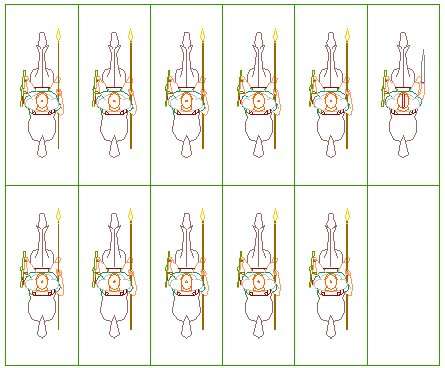 The Decuria could be configured two ways, the first was shown in the detail above and again on the left of this drawing. The other configuration is two horsemen wide by ten deep. In some combination, this arrangement seems to fit better. This formation is 12' wide and 50' deep.
The Decuria could be configured two ways, the first was shown in the detail above and again on the left of this drawing. The other configuration is two horsemen wide by ten deep. In some combination, this arrangement seems to fit better. This formation is 12' wide and 50' deep.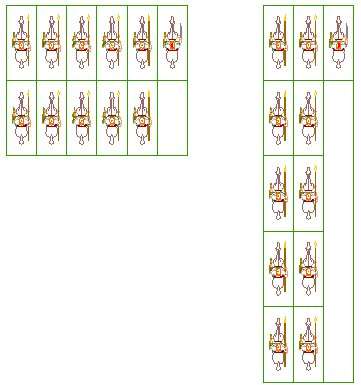
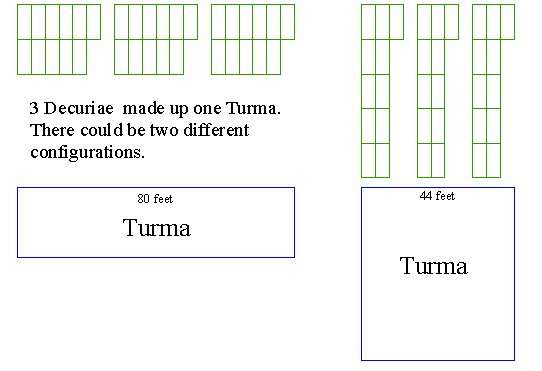
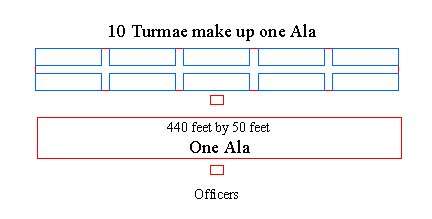 Ala, wing, was the general term for the allied units in the Republican armies. As the number of cavalry, increased the Ala came to mean a separate unit of cavalry within the overall force. Some sources say that the allied auxiliary cavalry units were divided into Turmae in the Roman model. Certainly the cavalry units that were specifically Roman were organized this way. The drawing on the left shows how the 10 Turmae could be arranged into a single Ala. The Turma configurations are based on the two-deep, five-abreast formation of the Decuria, two Decuriae deep and five wide which gives a rectangular formation for the Turma.
If the Ala were to be split so that it could support both flanks then the configuration below could have worked. It is based on the two-abreast, five-deep configuration of the Decuriae which creates an almost square Turma. There are five Turmae on either side, the small red square represents the officers who could have been located at any position.
Ala, wing, was the general term for the allied units in the Republican armies. As the number of cavalry, increased the Ala came to mean a separate unit of cavalry within the overall force. Some sources say that the allied auxiliary cavalry units were divided into Turmae in the Roman model. Certainly the cavalry units that were specifically Roman were organized this way. The drawing on the left shows how the 10 Turmae could be arranged into a single Ala. The Turma configurations are based on the two-deep, five-abreast formation of the Decuria, two Decuriae deep and five wide which gives a rectangular formation for the Turma.
If the Ala were to be split so that it could support both flanks then the configuration below could have worked. It is based on the two-abreast, five-deep configuration of the Decuriae which creates an almost square Turma. There are five Turmae on either side, the small red square represents the officers who could have been located at any position. The standard pre-Marian army was comprised of four legions and one cavalry unit. That army is shown in the drawing below.
The standard pre-Marian army was comprised of four legions and one cavalry unit. That army is shown in the drawing below.
 Even if allied cavalry were not organized into Decuriae, Turmae and Alae, the space the cavalry would have occupied would be roughly the same as shown here. The following drawing shows a force of five post-Marian legions with 5,000 supporting cavalry.
Even if allied cavalry were not organized into Decuriae, Turmae and Alae, the space the cavalry would have occupied would be roughly the same as shown here. The following drawing shows a force of five post-Marian legions with 5,000 supporting cavalry.
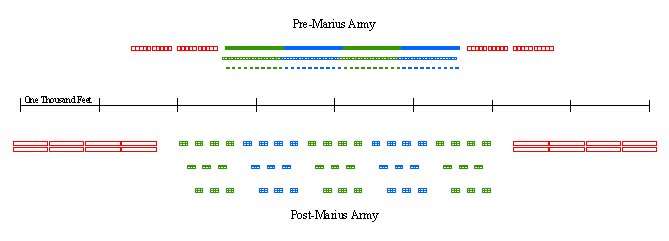 The Pre-Marius army has a total front of just under 6,000 feet. The Post-Marius army exceeds 8,000 feet. The impact of echelon-tactics in making the formation deeper is also apparent.
The Pre-Marius army has a total front of just under 6,000 feet. The Post-Marius army exceeds 8,000 feet. The impact of echelon-tactics in making the formation deeper is also apparent.
 The basic cavalry soldier was almost always armed with a shield and stabbing/throwing spear, supplemented by a sword. The Romans were never noted for using mounted archers, for example. The appearance of the cavalry soldier would surely have changed over time but the figure would be a good generalization of the soldier at almost any time in Rome's history.
The basic cavalry soldier was almost always armed with a shield and stabbing/throwing spear, supplemented by a sword. The Romans were never noted for using mounted archers, for example. The appearance of the cavalry soldier would surely have changed over time but the figure would be a good generalization of the soldier at almost any time in Rome's history.
 Each Ala had an aeneator, shown on the left with the curved cavalry horn, an officer and a vexillarius, shown on the right with the red banner.
Each Ala had an aeneator, shown on the left with the curved cavalry horn, an officer and a vexillarius, shown on the right with the red banner.
The Decuria
The basic unit of the cavalry, the decuria, seems to have been the same throughout the legion’s history. It was a formation of ten men with a Decurio as the commander. In the drawing below, each horseman is allotted a space of 4’ by 10’. The Decurio is shown positioned to the right of the formation in a file of his own. This formation is five horsemen wide by two deep, plus the Decurio; it is 24’ wide and 20’ deep. The Decuria could be configured two ways, the first was shown in the detail above and again on the left of this drawing. The other configuration is two horsemen wide by ten deep. In some combination, this arrangement seems to fit better. This formation is 12' wide and 50' deep.
The Decuria could be configured two ways, the first was shown in the detail above and again on the left of this drawing. The other configuration is two horsemen wide by ten deep. In some combination, this arrangement seems to fit better. This formation is 12' wide and 50' deep.
The Turma
Three Decuriae made up the next largest unit, called the Turma. It would have been comprised of 33 men. The drawing below shows two configurations of the Turma based on the two different ways the Decuria could be arranged.
The Ala
 Ala, wing, was the general term for the allied units in the Republican armies. As the number of cavalry, increased the Ala came to mean a separate unit of cavalry within the overall force. Some sources say that the allied auxiliary cavalry units were divided into Turmae in the Roman model. Certainly the cavalry units that were specifically Roman were organized this way. The drawing on the left shows how the 10 Turmae could be arranged into a single Ala. The Turma configurations are based on the two-deep, five-abreast formation of the Decuria, two Decuriae deep and five wide which gives a rectangular formation for the Turma.
If the Ala were to be split so that it could support both flanks then the configuration below could have worked. It is based on the two-abreast, five-deep configuration of the Decuriae which creates an almost square Turma. There are five Turmae on either side, the small red square represents the officers who could have been located at any position.
Ala, wing, was the general term for the allied units in the Republican armies. As the number of cavalry, increased the Ala came to mean a separate unit of cavalry within the overall force. Some sources say that the allied auxiliary cavalry units were divided into Turmae in the Roman model. Certainly the cavalry units that were specifically Roman were organized this way. The drawing on the left shows how the 10 Turmae could be arranged into a single Ala. The Turma configurations are based on the two-deep, five-abreast formation of the Decuria, two Decuriae deep and five wide which gives a rectangular formation for the Turma.
If the Ala were to be split so that it could support both flanks then the configuration below could have worked. It is based on the two-abreast, five-deep configuration of the Decuriae which creates an almost square Turma. There are five Turmae on either side, the small red square represents the officers who could have been located at any position. The standard pre-Marian army was comprised of four legions and one cavalry unit. That army is shown in the drawing below.
The standard pre-Marian army was comprised of four legions and one cavalry unit. That army is shown in the drawing below.
An auxiliary cavalry army
The legions came to use large numbers of allied cavalry, numbering in the thousands. The drawing below shows one way such a force might have looked if it were organized into Alae. Each of the red boxes represents one Ala of 330 men. The sixteen Alae make up a force of 5,280 men. Three formations are shown. At the top the force is shown divided into two wings of eight Alae each. These formations are each eight men deep and measure 1,820' wide by 120' deep. Below that are two more compact groupings, 900' wide by 260' deep. And at the bottom is a single massed unit of all sixteen Alae. Even if allied cavalry were not organized into Decuriae, Turmae and Alae, the space the cavalry would have occupied would be roughly the same as shown here. The following drawing shows a force of five post-Marian legions with 5,000 supporting cavalry.
Even if allied cavalry were not organized into Decuriae, Turmae and Alae, the space the cavalry would have occupied would be roughly the same as shown here. The following drawing shows a force of five post-Marian legions with 5,000 supporting cavalry.
Two armies with cavalry
The above drawings of the two armies are deceptive because they are not done to the same scale. The drawing below shows the two armies, pre- and post-Marian at the same scale. It is immediatelyobvious that the latter army is much larger. The Pre-Marius army has a total front of just under 6,000 feet. The Post-Marius army exceeds 8,000 feet. The impact of echelon-tactics in making the formation deeper is also apparent.
The Pre-Marius army has a total front of just under 6,000 feet. The Post-Marius army exceeds 8,000 feet. The impact of echelon-tactics in making the formation deeper is also apparent.

